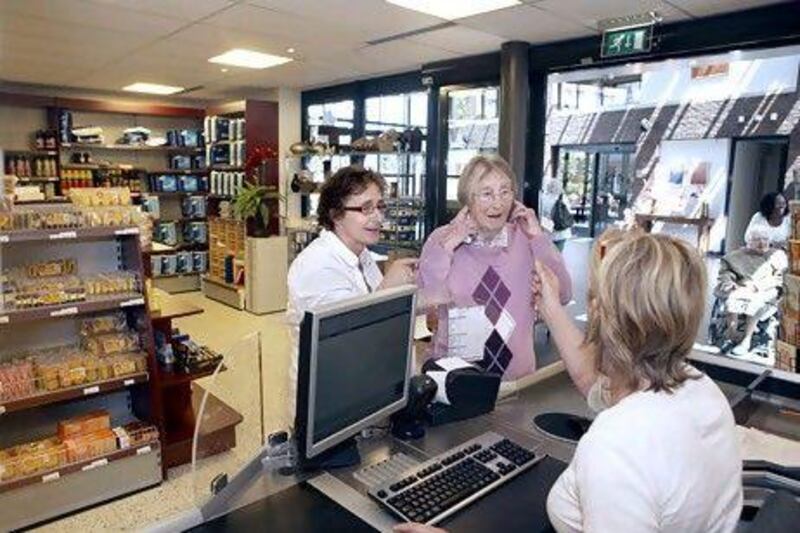WEESP, THE NETHERLANDS // The elderly woman in a sand-coloured windbreaker walked briskly along the path around a manicured lawn and a small pond in a typically Dutch suburban setting.
"Good afternoon, sir", she offered somewhat formally as she came by.
Nothing remarkable in that, down to the grey and windy Dutch summer weather, except that the same woman kept passing by several times over the next hour at several locations around the neighbourhood, each time saying the exact-same greeting and then marching on blithely.
The neighbourhood is called Hogeweyk, in the village of Weesp near Amsterdam, and it is inhabited by residents who are at an advanced stage of dementia. It is unique in Europe in that it is an entire self-contained, purpose-built quarter, with shops, cafe's, restaurants, squares and single-storey villas where people with dementia can move about freely and live as much as possible of a "normal" life.
With an ageing population expected to lead to rising numbers of people with dementia, Europe is in dire need of care solutions that show more compassion for the elderly and keep spiralling costs under control.
"We should be ashamed of what we have done to our elderly in the past. To stick them in a care home with several people to a room, without any pleasure in life, just to put them away," said Eloy van Hal, one of the managers of Hogeweyk who has been involved in planning and building the care facility that opened in 2009.
Hogeweyk's 153 residents live in 23 villas, usually six - a maximum seven - people to a unit. Each resident has their own bedrooms and share a living room, kitchen and bathrooms. At least one caretaker is present all day in a villa, from early in the morning to late at night with a skeleton staff in the neighbourhood overnight.
Hogeweyk is part of the national health care. Most of the money comes from the state with some of the residents making monthly contributions depending on their income. Every citizen is eligible, with priority given to people from the region.
Caretakers help the residents cook, do laundry, shop and guide them back to their villas and rooms when needed. "Some still enjoy doing things and we help them. Others just want to sit around and not do much and that's also OK," said Anja Almer, one of the caretakers in a villa with what Hogeweyk terms a "homey" style.
A selection of different lifestyles for residents, usually for their family members to choose from, is another point of pride for Hogeweyk. Besides homey, these include such choices as posh, cultural, arts and crafts and Christian. "In the rest of their lives people are not all the same, so why should they be forced to be so here? People don't all like to listen to the same music or watch the same programmes," Isabella van Zuthem, Hogeweyk's spokeswoman, said.
To what degree the residents are aware of the subtle differences is open to debate. Toos Borst-Vial, a lively resident who described herself as being about 80 years old, voiced her appreciation for the home but then veered into fantasy, saying: "Oh no, I'm not staying for dinner. I'm just visiting. I have to go home and prepare dinner for my husband and children."
Standard elderly care facilities in the Netherlands often have a closed wing for dementia patients who are not allowed to wander freely. They often share rooms and may even be tied to their beds. But with its lawns, villas, facilities and staff, Hogewyk's affordability is question at a time when national health budgets in Europe are under pressure.
Health care, including care for the elderly, in the Netherlands represented the largest single item in the 2012 budget, almost 30 per cent, at ?74.5 billion (Dh337.17bn). With the economy in recession, the government cut that by ?1.6bn for 2013, even though costs are rising, mostly because of an ageing population.
The picture is not much different in the rest of Europe. Figures from Eurostat, the EU's statistical bureau, show that while one in six people in the EU are older than 65, that will rise to one in four by 2040. The incidence of dementia rises sharply with old age.
Mr Van Hal, the Hogewyk manager, acknowledged that money is an issue as an increasing number of people need care but he said that Hogeweyk is not much more expensive to run than any other care facility.
"You have to make different choices in the way you staff it and spend money," said Mr Van Hal. He said Hogewyk residents use less medication and require fewer doctors than in other homes because they are calmer and more stable in their surroundings.
But Hogeweyk may already be obsolete even as several countries, notably Switzerland and Germany are making plans to emulate it. Marieke van der Waal, of the Dutch branch of the International Longevity Centres, an old-age research organisation, said that the movement is increasingly towards letting the elderly stay in their own surroundings.
"What we want for the future is for everybody, however badly they have dementia, to stay in their own homes," she said. This would be good for the elderly, if properly facilitated and accompanied, and could actually save money, she said.
"In Denmark they needed to reform the care for the elderly because of financial pressures but it also appears to be better for the people," she said.
Mr Van Hal agreed that different forms of care should be examined: "Next time I would not build a Hogeweyk, I'd build a safe quarter for people with dementia in combination with room for others."
foreign.desk@thenational.ae
Dutch build community for dementia patients
Europe's ageing population demands innovations in ways to care for elderly with compassion while balancing growing health care costs.

Editor's picks
More from the national





